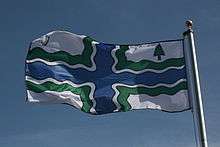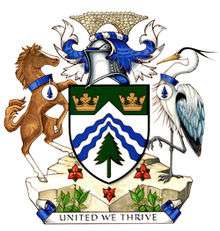Waterdown, Ontario
| Waterdown | |||
|---|---|---|---|
| Dissolved municipality | |||
|
Waterdown Public Library | |||
| |||
| Motto: United we thrive | |||
| Country | Canada | ||
| Province | Ontario | ||
| City | Hamilton | ||
| Village of Waterdown | 1830 | ||
| Amalgamation with Flamborough | 1974 | ||
| Incorporated | 2001 | ||
| Population (2011) | |||
| • Total | 17,048 | ||
| Time zone | Eastern (EST) | ||
| Forward sortation area | L8B, L0R2H0, & L0R2M0 | ||
| Area code(s) | 905 / 289 / 365 | ||
| Highways |
| ||
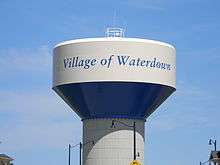
Waterdown is a community in Canada which since 2001 has been a community of Hamilton, Ontario.
On January 1, 2001 the new city of Hamilton was formed from the amalgamation of six municipalities: Hamilton, Ontario, Ancaster, Dundas, Flamborough, Glanbrook, and Stoney Creek. Before amalgamation, the "old" City of Hamilton had 331,121 Hamiltonians divided into 100 neighbourhoods. The new amalgamated city has 490,268 people in over 200 neighbourhoods.[1]
Waterdown was created from that part of East Flamborough Township on the edge of the Niagara Escarpment, just east of the junction of King's Highways Nos. 5 and 6. That intersection is known as Clappison's Corners, but continuous residential and commercial buildings between the two communities make it difficult to see any difference.
Community institutions include:
- Waterdown District High School
- Allan A. Greenleaf Public School
- Flamborough Review (merged with the Flamborough Post)
- Flamborough Family YMCA
- 3rd Waterdown Scouting
- Village Theatre Waterdown
- The Waterdown East Flamborough Heritage Society
In 1974, the village was amalgamated with East Flamborough, West Flamborough and Beverly townships to form the Town of Flamborough. In 2001, Flamborough and 5 other municipalities were amalgamated into the City of Hamilton.
Waterdown is expanding greatly, with the recent addition of a YMCA and several commercial establishments. Because of the approval of new homes in Waterdown – at least 6,500 more houses in the near future – there are ongoing discussions regarding the planned $50 million 'Waterdown By-Pass', which would allow for easier access across the city. Waterdown population growth was approximately 28.9% over the years 1996 and 2001.
In 2012, the average house price in Waterdown was nearly $400,000.[2]
Waterdown District High School (WDHS) expanded its facilities in 2012.
Population of Greater Waterdown
- 1996 — 11,632
- 2001 — 14,988
- 2011 — 17,048
History
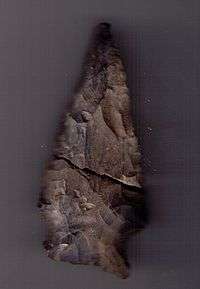
Indigenous Nations
Perched atop the Niagara Escarpment, the area that became Waterdown has been inhabited for thousands of years. Professor John Triggs of Wilfrid Laurier University found evidence of Algonquin-speaking Aboriginals from as far back as 7,500 BCE.[3] One of the earliest known groups to inhabit the area was the Chonnonton Nation. Diseases introduced by French explorers and missionaries devastated the Neutral Confederacy, allowing it to fall victim to invasion by the Haudenosaunee around 1650. The Jesuits in Quebec City wrote that the Chonnonton Nation was driven from the area by 1653, with remnants of the once powerful group reportedly migrating to seek shelter with the Anishinabe nations on Lake Huron and Lake Superior.
Following the war, the area around Waterdown was sparsely inhabited by newly arrived Haudenosaunee. The Haudenosaunee village of Tinawatawa (alternatively spelled Quinaouatoua) was located near to Waterdown, likely somewhere along the upper course of Grindstone Creek, and was one of only a few villages established in the newly conquered territories. Following the upheaval of the so-called Beaver Wars the Haudenosaunee abandoned their settlements north of Lake Ontario, and the Mississaugas moved into the region.
Robert de la Salle explores Flamborough
1669 saw French explorer Robert de la Salle follow Spencer Creek (from Lake Ontario) up toward present-day Westover and the Indigenous settlement of Tinawatawa. It was here that la Salle met up with another French explorer, M. Louis Joilet. Some historians think this meeting happened along the shores of Lake Medad (northeast of present-day Waterdown, beside Hidden Lake Golf Club).[4]
British Conquest of 1760 and the American Revolution
After the fall of New France the region changed dramatically. The Anishinabe forged an alliance with the British Crown that was reaffirmed by King George III's Royal Proclamation of 1763 and the Treaty of Niagara. For the Europeans, the region became part of the Province of Quebec that was created by the British Crown.
The area remained largely unaffected until the American Revolution unleashed a flood of Loyalists fleeing the American republic. Access was largely restricted to water, so the first settlements were along the coast of Lake Ontario. To facilitate the English-speaking settlers, the Province of Quebec was broken into Upper and Lower Canada with Lieutenant Governor John Graves Simcoe as the first representative of the Crown for Upper Canada. It was John Graves Simcoe that was walking along the beach strip of Hamilton that looked up at the escarpment and named its northern arm around Burlington Bay "Flamborough" because it reminded him of Flamborough Head in Yorkshire, England.
The Flamborough area came into Treaty with the Crown on May 22, 1784 (formally confirmed by Treaty No.3 in 1792). The frontline of the new township was laid out by John Collins in 1790 with further surveys conducted through to 1797. Originally meant to be the Township of Flamborough, it was broken into the separate entities of East Flamborough and West Flamborough in 1798. Today Waterdown is the largest settlement in the former township of East Flamborough.[5]
Alexander Brown and Merren Grierson
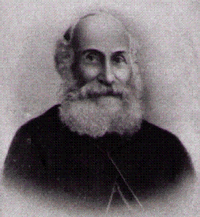
One of the first land grants in the area was to Lt. Alexander MacDonell of Butler's Rangers. MacDonell never visited the area, but ended up selling 800 acres to Alexander Brown of the North West Fur Company in 1802. Brown built a log cabin and sawmill at the top of the Great Falls in present-day Smokey Hollow in 1805, making him the first European settler in the region. Alexander Brown married Merren Grierson and was a key figure in the community until his death in 1852. Alexander Brown II moved down Grindstone Creek to the site of present-day LaSalle Park, building a wharf (called "Brown's Wharf" or "Port Flamboro") to export the many things being created by the mills that quickly sprung up in the Waterdow-area.[6] It was Alexander Brown that built the first school of the village (on the site of the present-day American House) in 1815, employing Mary Hopkins as its first teacher.[7]
Ebenezer Griffin - the founder of Waterdown
It was the arrival of entrepreneur Ebenezer Culver Griffin in 1823, purchasing over half of Alexander Brown's property, that marked the true beginning of the Village of Waterdown. It was Griffin that had his property surveyed into village lots in 1830.
The name "Waterdown"
A local story credits Ebenezer Griffin with giving Waterdown its name. A prohibitionist, Griffin did not approve of the vast quantities of alcohol being consumed during the Victorian Age, including the whiskey used to christened new mills. During the christening of one of Griffin's mills the carpenter called out for its name and someone in the crowd called out "Hey Ebenezer, throw that water down." The carpenter heard the name "Waterdown" and it was given to the mill and soon adopted by the emerging village.[8] It is important to note that Alexander Brown did not share Griffin's displeasure of alcohol.
Industrial Revolution

Waterdown was born out of the Industrial Revolution. Thanks to the plan drawn up by Ebenezer Griffin, settlers and industrialists rooted themselves in village life. Mills grew along the banks of Grindstone Creek (especially in the area known as Smokey Hollow - given this name because of all the smog caused by the many complexes) as individuals like William P. Howland arrived to make their fortune. By 1879 the settlement was severed from the Township of East Flamborough and incorporated as a Village in its own right with quarrier Charles Sealey as its first reeve. Waterdown remained its own municipality until it was absorbed into the Township of Flamborough in 1974.
2001 Forced Amalgamation
Ontario's Conservative Ontario embarked on a province-wide restructuring on municipal government, amalgamating several municipalities into larger ones. It was proposed that Flamborough amalgamate with five other municipalities into a new City of Hamilton. Many Waterdown residents disagreed with this proposal. Due to Waterdown's location as a sandwich town, resting between Burlington and Hamilton, residents argued that Hamilton would not extend city services, such as bus routes, to Waterdown. Instead, they suggested that Flamborough be split into parts, with Waterdown amalgamating with Burlington. Burlington had expressed some interest in amalgamation and there was support for this idea in Waterdown. Burlington is closer geographically and the Aldershot and Kerncliff Park neighbourhoods wrap around the south and east ends of the community. Burlington had also expressed a willingness to expand bus service to Waterdown.
However, despite a local campaign to sway the government, Waterdown was amalgamated into Hamilton with the rest of Flamborough. This prompted the elected MPP at the time, Conservative Toni Skarica, to resign from his position. Skarica ran (and won) partially due to a platform of keeping Flamborough unamalgamated, and vowed to resign if the government forced an amalgamation with Hamilton. He gained a brief local celebrity status during that time because of his stance.
Souharissen Natural Area

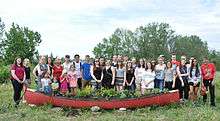
On August 21, 2014, the Souharissen Natural Area was dedicated in Waterdown by the Honourable David C. Onley, 28th Lieutenant Governor of Ontario, and Chief Bryan Laforme and Council of the Mississaugas of the New Credit First Nation. Over 50 people attended the dedication including David Sweet MP, Councillor Judi Partridge, Carolyn King, United Empire Loyalists, and other members of the Mississaugas of the New Credit. The day began with the lighting of the first sacred fire in over two centuries, signally the formal return of the Mississaugas to their traditional territory.
The Souharissen Natural Area covers 27 acres in the Village of Waterdown, and is the result of years of work following the discovery of 104 Indigenous archeological sites in the Waterdown Bay Development Area in 2005.
Along with the Aboriginal sites, the foundations of an early-19th century dwelling were uncovered in the area. This dwelling may have been used by the first European settlers of Waterdown, Alexander Brown and Merren Grierson. The Natural Area includes a plaque identifying this important landmark, as well as detailing the histories of Merren Grierson and Alexander Brown, that was unveiled by the Lieutenant Governor, Chief LaForme and researcher Kekoa Reinebold.
Later that day a community feast was held in Waterdown at a local residence in honour of the return of the Mississaugas of the New Credit First Nation to Flamborough, as well as the visit by both the Lieutenant Governor of Ontario and Chief of the Mississaugas of the New Credit. Everyone who was part of the dedication, including the Lieutenant Governor and Chief Laforme attended.[9]
The Queen's Bench
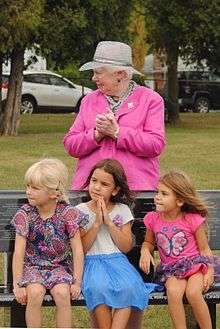
Flamborough has a tradition of honouring Royal milestones, including the "Queen's Trees" located in Harpers Corners, outside the library and at Memorial Park. On September 9, 2015, the Honourable Elizabeth Dowdeswell, 29th Lieutenant Governor of Ontario, visited Waterdown to unveil the Queen's Bench in Memorial Park. The bench commemorates that on that day the reign of Queen Elizabeth II surpassed that of Queen Victoria, making it the longest reign in Canada’s modern era. The bench is engraved with many of the Canadian milestones of Her Majesty Queen Elizabeth II, Queen of Canada. The project was completed thanks to generous donations made by members of the community.[10]
Natural attractions
Waterdown, and its associated Great Falls, (also called Grindstone Falls, so named for the Grindstone Creek that feeds it, or Smokey Hollow Falls, so named for the smoke rising from the hollow from the mills, or Barnes' Falls, named after the Barnes family who owned the property until 1978), are located on the local portion of the Bruce Trail System in Ontario. Many national and regionally rare flora species grow in the natural areas of Waterdown.
The Smokey Hollow falls originally powered a sawmill and gristmill when the town was founded, and later a number of other small mills, and as a result of demand on the limited water supply, time shared the water. The last operating saw mill (Slater's Lumber Mill) continued to produce lumber well into the 1970s. It was located along the Grindstone Creek behind the Knox Presbyterian Church at the corner of Mill Street North and Church Street. During the 1950s and part of the 1960s the mill used horses and heavy tackle to haul the logs to the cutting area. Today, only remote foundation ruins of the mills remain, although a lookout over the falls and a signboard detailing the history of the area is in place.[11]
Furthermore, Waterdown also has many wetland trails in the eastern end of town which are well marked and have informational signage.[12]
Other attractions
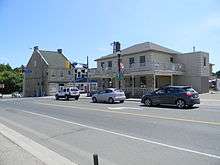
Of interest are several historical buildings which remain from the founding of the town, these include the Royal Coachman (originally the Kirk House, or Kirk Hotel), American House, the former-library, and numerous private residences and businesses.
Waterdown is also home to local community institutions such as Pickwick Books, Red Sky Design, Waterdown Cycle and the Waterdown Legion.
Waterdown is also home to a hockey arena, Harry Howell Arena, which is home of the Flamborough Hockey Association,[13][14] the Flamborough Girls Hockey Association, and the Flamboro Skating Club[15]
Each July 1 weekend Waterdown hosts of the Oh Canada! Ribfest,[16] a joint community focused event sponsored by the Rotary Clubs of Flamborough AM[17] and Waterdown.[18] Tens of thousands of people, from Waterdown and surrounding communities, fill Memorial Park enjoying local music artists, dancers, midway rides, kids' activities, and of course tasty ribs!
Notable people
- Sir William P. Howland (1811–1907), Lieutenant-Governor of Ontario (1868–1873), Father of Confederation, Industrialist. Sir William Pearce Howland was born at Paulings in New York State of the United States of America on May 29, 1811, the second son of Johnathan Howland and Lydia Pearce. He was educated at the Kinderhook Academy; and in 1830 he came to Upper Canada. He first settled at Cookstown, near York (Toronto), where he went into business with his brother. In 1840 he purchased the Lambton mills in York County; and shortly afterwards he established a wholesale grocery business in Toronto. Though he was sympathetic to the Reform movement, he refused to implicate himself with the Rebellion of 1837. In 1841 Howland became a naturalized Canadian. In 1857 he was elected as a Reformer to represent West York in the Legislative Assembly of Canada; and he continued to represent the constituency, first in the Assembly, and then in the House of Commons until 1868. From 1862 to 1863 he was Minister of Finance in the S. Macdonald-Sicotte Government and in 1863/64 he was Receiver-General in the S. Macdonald-Dorion Government. In November 1864, he entered the Great Coalition with the portfolio of Postmaster-General. When George Brown retired from the cabinet in 1865, Howland, with William McDougall declined to follow him. In 1866 Howland's portfolio was changed to finance. In 1867 he was appointed Minister of Inland Revenue in the first cabinet of the Dominion of Canada. The following year, Howland retired from office to accept the Lieutenant-Governorship of Ontario, a position in which he remained until 1873. He then retired from public life. He continued in business, running one of the largest mills in the Smokey Hollow industrial complex, until his son died in 1900. Howland died on January 1, 1907.[19]
- Todd Harvey, (1975–), Retired NHL hockey player. Also had a successful junior career, which included being the captain of the Canadian team at the World Junior Hockey Championships.[20]
- Mark Visentin, (1992–) Ice hockey player, Goalie for the Portland Pirates of the American Hockey League (AHL), drafted by the at the time, Phoenix Coyotes (1st round, 27th overall, 2010 NHL entry draft), member of 2008 U17 Team Canada gold medal team, began hockey career playing for the Flamborough Sabres AA in 2000, winning OMHA gold medals in 2001 (undefeated season) and 2002, member of Halton Hurricanes AAA team for six years winning 5 OMHA medals and member of Waterdown Wolves Rep Baseball team for seven years winning 5 provincial championships, Awarded Hamilton Civic award (2004), and Halton Hills Civic Award (2005) for Junior Athletic achievement. In December 2010, Visentin was named to Team Canada Under-20 that won a silver medal at the 2011 World Junior Ice Hockey Championships in Buffalo, New York. In December 2011, Visentin was named to Team Canada again for the 2012 World Junior Ice Hockey Championships in Calgary and Edmonton.
- John Williams, Jr., (1977–), Canadian Football League (CFL) Player. Played for the B.C. Lions, the Edmonton Eskimos, Toronto Argonauts, and the Hamilton Tiger Cats. Along with his father John Williams Sr. is the only father son combination in CFL history to both have won a Grey Cup. Jr.- 2002, Sr.- 1972.
- Leo Clarke Waterdown-born recipient of the Victoria Cross for actions during the Battle of Flers-Courcelette in the First World War
- Dylan Everett, (1995–) Gemini-nominated actor, best known for his roles on Canadian teen comedies and dramas.
- Erin Pitt, (1999–) actress, best known for her role as Isabelle in An American Girl: Isabelle Dances into the Spotlight.
 Watertower
Watertower Waterdown, Great Falls
Waterdown, Great Falls Waterdown, Great Falls
Waterdown, Great Falls Waterdown, Great Falls
Waterdown, Great Falls Waterdown's Public Library
Waterdown's Public Library Waterdown's Pub The Royal Coachman
Waterdown's Pub The Royal Coachman Waterdown's Gas Station
Waterdown's Gas Station
References
- ↑ Manson, Bill (2003). Footsteps In Time: Exploring Hamilton's heritage neighbourhoods. North Shore Publishing Inc. ISBN 1-896899-22-6.
- ↑ "Sold! Housing boom brings radical changes to a new Waterdown". 2013-08-04. Retrieved 2015-06-14.
- ↑ Tidridge, Nathan (2011). The Extraordinary History of Waterdown and East Flamborough. Waterdown: St*one Soup Publications. p. 6. ISBN 978-0-9734438-1-3.
- ↑ Mills, Stanley (1937). Lake Medad. Hamilton.
- ↑ Tidridge, Nathan (2011). The Extraordinary History of Waterdown and East Flamborough. Waterdown: St*one Soup Publications. ISBN 978-0-9734438-1-3.
- ↑ Woods, Donald R. and Diane E. (2011). The Mills of Waterdown. Waterdown: The Waterdown East Flamborough Heritage Society. ISBN 0-921592-50-7.
- ↑ Tidridge, Nathan (2015). The Extraordinary History of Flamborough. waterdown: Flamborough Heritage Society.
- ↑ Parker and Woods, Allan and Diane (1984). Exploring the Past: Waterdown. Waterdown: W.L. Printing Limited.
- ↑ http://www.tidridge.com/souharissen-natural-area-waterdown.html
- ↑ http://www.tidridge.com/the-queens-bench-at-memorial-park.html
- ↑ "Hamilton- Waterfall Capital of the World". (www.cityofwaterfalls.ca) from Joe Hollick's list. Retrieved 2008-08-22.
- ↑ Hamilton Waterfalls and Cascades: Research & Inventory Report, 2nd Edition. Hamilton Conservation Authority. November 2007. pp. 22–44.
- ↑ "Hamilton Arenas Listing". Retrieved 2008-08-22.
- ↑ "Arenas Maps: Ontario". Retrieved 2008-08-22.
- ↑ "Flamboro Skating Club". flamboroskatingclub.com. Retrieved 2016-01-04.
- ↑ "Oh Canada Ribfest". Oh Canada Ribfest. Retrieved 2016-01-04.
- ↑ "Flamborough AM - Home Page". portal.clubrunner.ca. Retrieved 2016-01-04.
- ↑ "Waterdown - Home Page". portal.clubrunner.ca. Retrieved 2016-01-04.
- ↑ The MacMillan Dictionary of Canadian Biography, fourth edition. Toronto: Macmillan of Canada. 1974.
- ↑ Cole, Stephen (2006). The Canadian Hockey Atlas. Doubleday Canada. ISBN 978-0-385-66093-8.
External links
| Wikimedia Commons has media related to Waterdown. |
- Rotary Club of Waterdown
- Watedown BIA
- Flambourough Chamber of Commerce
- Waterdown Ontario Online - Waterdown & Flamborough Community Website
- The Waterdown Ghost : From Waterdown Heritage
Coordinates: 43°20′N 79°53′W / 43.333°N 79.883°W
